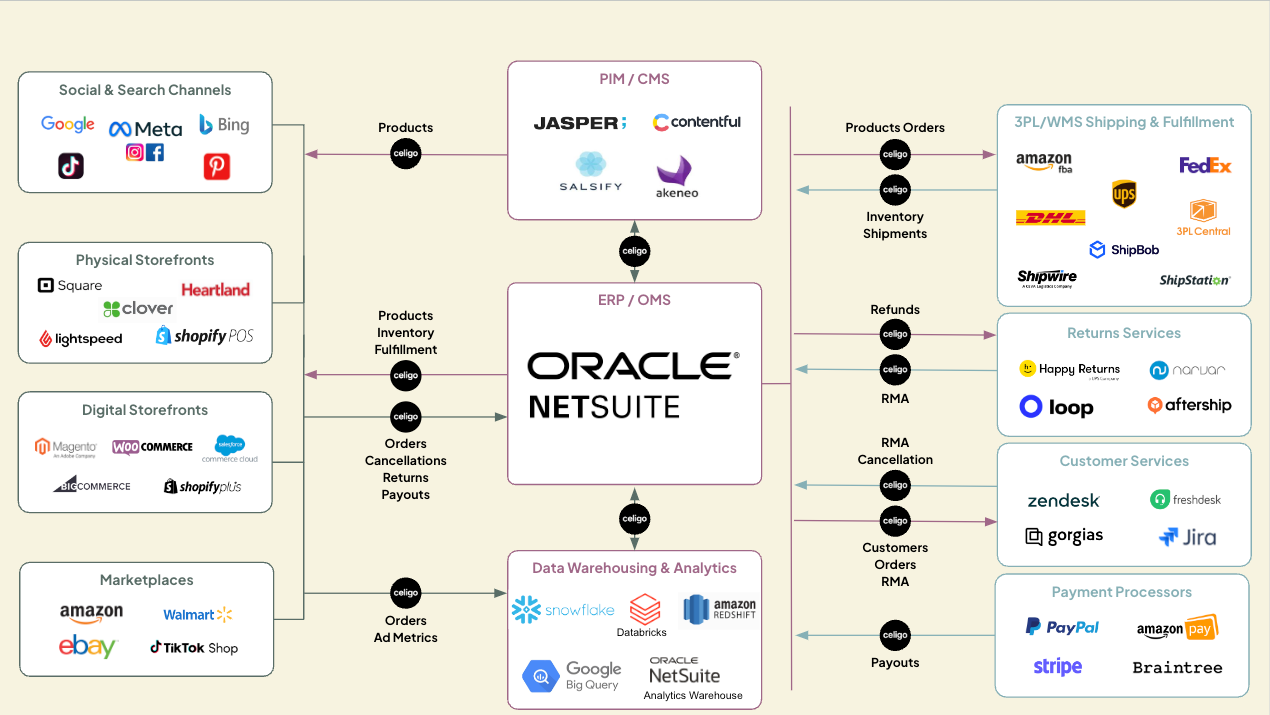Published Oct 25, 2024
Embracing omnichannel strategies with integration

- Adopting multiple sales channels isn’t enough to create positive customer experiences.
- To achieve omnichannel success, businesses must unify and centrally manage operations.
- Leverage integration-driven automation to scale and optimize your ecommerce operations.
Creating exceptional ecommerce experiences goes beyond simply being active on multiple platforms. It’s about delivering a seamless, consistent journey for customers across every channel.
To achieve this level of coordination, you need to automate your processes—from product listings and inventory to order management and fulfillment. That’s where Celigo’s Integration Platform as a Service (iPaaS), comes into play.
Celigo helps you integrate your core systems and automate critical ecommerce processes. This not only provides a smooth, error-free experience for your customers but also enables you to scale more efficiently.
Explore the impact ecommerce automation could have on your business with our webinar, “Master omnichannel success: How to centralize and automate ecommerce with NetSuite integration.”
Dive into the highlights.
Why you need an omnichannel strategy
Today’s consumers navigate between various sales channels during their buying journey, and in order to reach them, many businesses have adopted a multichannel strategy. This involves investing in a range of different marketing and sales channels.
However, if each channel operates independently, manual data entry becomes necessary to reconcile siloed information. This leaves channels disconnected and customers frustrated.
Omnichannel commerce takes the multichannel approach a step further. Instead of simply offering multiple channels, an omnichannel strategy connects your social media, digital storefronts, and online marketplaces to create a cohesive customer journey. This also enables a range of new tactics like buy online, pickup in store.
To fully embrace an omnichannel strategy, you need to integrate your tech stack.
Unify your operations with automation
The first step toward automation is integrating your core systems. One way to do this is to use your enterprise resource planning (ERP) system, such as NetSuite, as a central data hub. By connecting all your channels—social media, physical storefronts, digital storefronts, and marketplaces—with your ERP, you can sync real-time data and create a single source of truth.
From there, you can integrate systems, like your third-party logistics (3PL) provider, returns services, customer service tools, payment processors, product information management system, and data warehouse. This allows you to sync product, inventory, fulfillment, order, and returns data to enable end-to-end automation.

Explore a few essential ecommerce automations made possible with integration:
- Order management: Connect your sales channels with your ERP and 3PL provider to sync order data between systems. This automation enables you to process orders without errors and delays, leading to improved customer satisfaction.
- Inventory management: Automate inventory management by integrating your ERP with your 3PL provider and sales channels. By doing so, you can guarantee that each channel reflects up-to-date inventory levels and prevent overselling and unnecessary inventory carrying costs.
- Returns management: Integrating your ERP and returns management system allows you to automate the entire returns and refunds process. This not only improves the customer experience by providing you real-time visibility into returns statuses but also keeps your inventory and cash flow data up to date.
- Reporting and analytics: Syncing data from all your systems to a central platform, like a data warehouse, helps you achieve a complete view of your business across channels. You can leverage this data for informed business decisions.
Discover how Celigo can help you sync inventory data between systems.
Embrace omnichannel commerce
To remain competitive and foster growth in today’s business landscape, adopting an omnichannel strategy is essential. Successfully implementing omnichannel commerce hinges on integration and automation.
Although there are several integration solutions available to you only an iPaaS offers a centralized platform to manage all your ecommerce integrations efficiently. By choosing an advanced iPaaS like Celigo, you can simplify the integration process even further by enabling non-technical users on your team to build, manage, and monitor integrations effortlessly. This ensures greater flexibility and control across your systems.
If you’re ready to move beyond siloed, manual processes and build a cohesive omnichannel strategy, this webinar is a must-watch. And, to see how Celigo’s platform can work for you, request a free demo.




